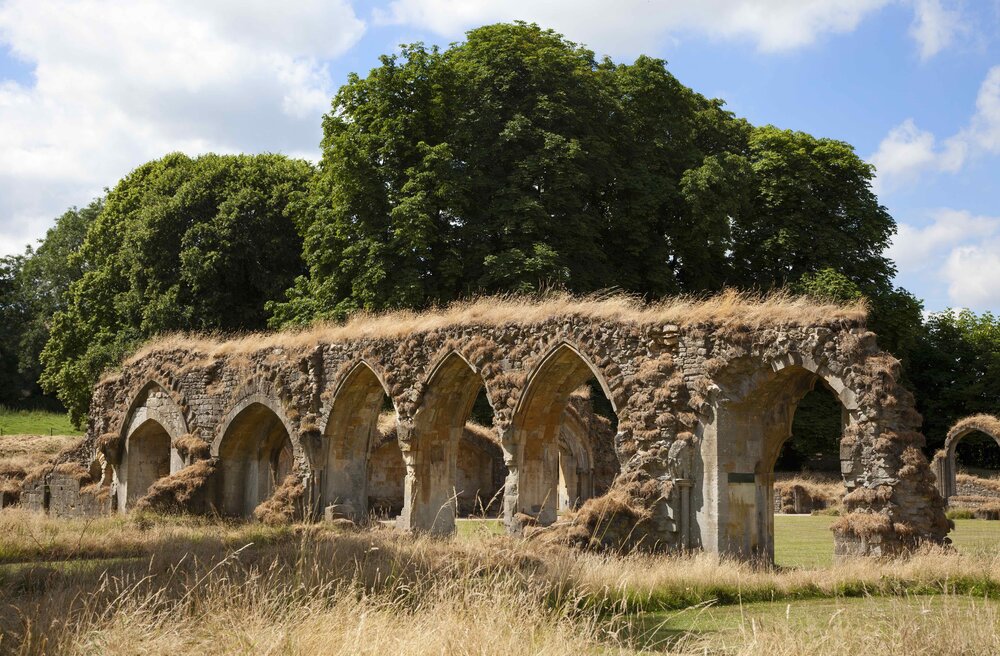The Abbey
Hailes Abbey was founded by Richard, Earl of Cornwall, in fulfillment of a vow he had made following his saviour from shipwreck, on land given him by his brother, King Henry III. It was given over to the monks of the austere Cistercian order, the rules of which required them to live quite remote from the daily vicissitudes of secular life and with an emphasis on a simple existence of work, love, prayer, and self-denial. The native population at Hailes, therefore, was transferred to neighboring Didbrook, leaving the former parish church to fall in 1248 under the jurisdiction of the abbey, and thereafter used as the place of worship for visitors, who were not allowed into the abbey precincts (except, presumably, on certain days when the vial of holy blood was displayed to pilgrims). The dedication ceremony was held on November 5, 1251, in the presence of King Henry III, Richard, Queen Eleanor, a number of nobles, and thirteen bishops.
The church, although its foundation is older, depended on the abbey. The history of the abbey is linked to the pilgrims that once walked here because its fame was due to its custody of vials of the Precious Blood of Christ (exposed at the time of the Dissolution variously as duck’s blood and “honey clarified and colored with saffron”). Until its exposure, it was the object of devotion by pilgrims, many of whom would have walked from Winchcombe, which was itself of some importance having been one of the principal towns of the Saxon kingdom of Mercia and indeed capital in the eleventh century of the short-lived county of Winchcombshire. Winchcombe had its own abbey, a Benedictine foundation, where St. Kenelm, a local saint widely venerated throughout this part of England, was buried. As a result, Winchcombe, too, was a place of pilgrimage and the flocks of pilgrims that came to both places were numberless enough to have been remarked on by medieval commentators. This little corner of Gloucestershire was holy indeed, yet of Winchcombe Abbey, there is now not a trace, and of Hailes Abbey little more than a tracework of stones. Nothing illustrates better the nature of the revolution that took place in English society in the sixteenth century than the razing of institutions that in power and influence had rivaled the very rulers of a country known for its faith. That English history is distinct from other European nations is very largely due to the tumult that ensued.
The abbey became famous only in 1270, when Richard’s son, Edmund, presented to the community a vial containing the blood of Christ, which he had purchased from the Count of Flanders in 1267. The relic came with a guarantee of its authenticity from the Patriarch of Jerusalem, a debatable claim in an era of crusading zeal that amounted to international hysteria. But it was good enough for the hundreds of thousands of pilgrims who made their way to Hailes over the following centuries until the dissolution of religious houses by Henry VIII. On Christmas Eve 1539 the abbey, found to be worth £357, making it the twelfth richest of the seventy-five Cistercian abbeys in the country, was destroyed. Yet, even today there exists a Catholic Priest with the title of Abbot of Hailes. He is known as a “Titular Abbot” — one who holds the title of a suppressed or destroyed abbey. The current holder seems to have a connection with an Irish order known as Mater Dei.
Hailes Church
The little church, across the road from the ruined abbey, has much of the abbey in it. Small as it seems from the outside, the interior is high and spacious, a concentrated version of medieval and pre-Reformation religious life, with its rood screen (which would once have been surmounted by a crucifixion), its medieval floor tiles, and its wall paintings. The paintings are striking to the English because there are very few churches in England where paintings survived the Reformation intact, decorative devices being regarded as Popeish fripperies. On the north wall is St. Christopher, the patron saint of travelers and therefore of pilgrims. The sight of the image of St. Christopher was believed to protect against the most dreaded of fates for a believer: death without confession. The saint was therefore painted extremely large and usually directly opposite the churches’ main entrance. In the chancel is an owl, symbolizing the night and so, too, spiritual desolation; and on the south wall a hunter with a horn to his mouth and panting greyhounds before him, apparently a representation of an eminent knight with connections to the abbey.
The tiles, many of which bear heraldic motifs relating to Richard and his ilk, and the stained glass in the east window, were all once part of the fabric of the abbey. It is possible to sense the veneration and love that brought pilgrims to this place, a sense of a time before upheaval brought a new and possibly unwelcome transformation to people’s lives. Gone was the color and intimacy of shared devotion to myriad saints and martyrs, the dependability of indulgences; but gone too was the disproportionate power of the church over secular destinies. England, over the course of a century, altered irrevocably and began its long process of renewal, which also took it along its own idiosyncratic path that was so much at odds with much of the rest of Europe.
Just outside the church is a medieval labyrinth, a grassy outline of decreasing circles. As it is almost flat, it is easily missed. Although there are many such mazes throughout the country, and across Europe, no one is precisely sure of their purpose; but it seems certain that at the very least they serve as aids to meditation, as one follows the path in and around, creating a personal corridor for prayer and thought. At the center is a small boulder marked with a cross, representing Jerusalem – it takes time to get there, if you are thinking – at which point, presumably earth and heaven collide before you retreat on yourself to return to reality cleansed and purified.


0 Comments